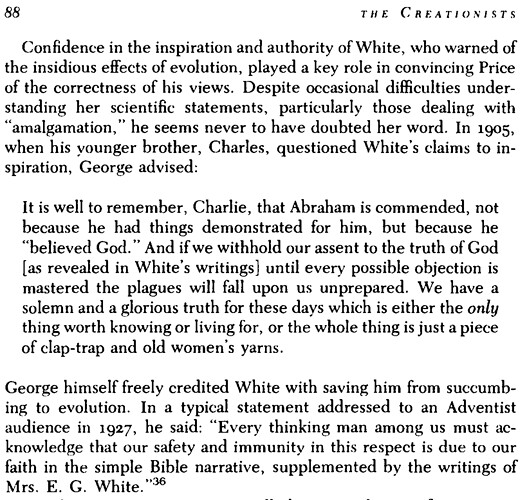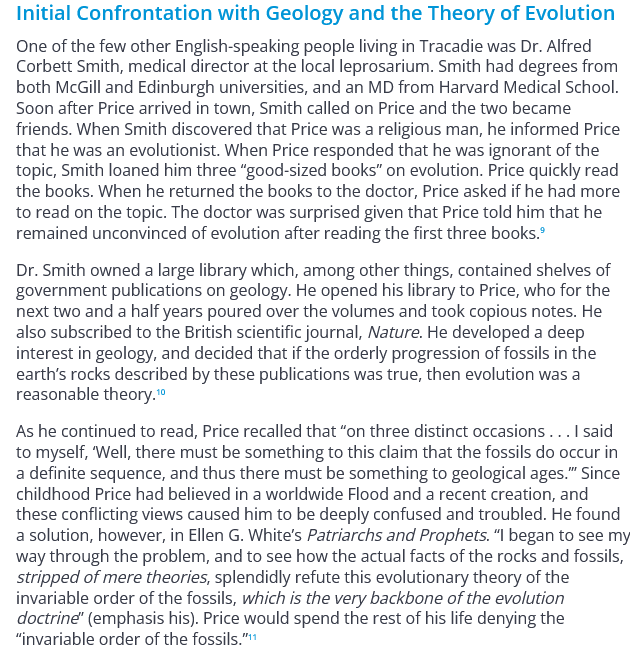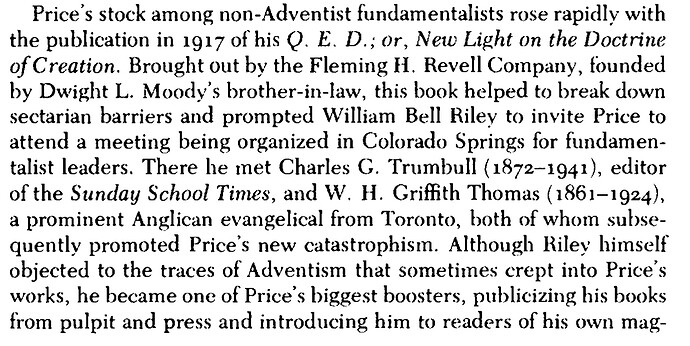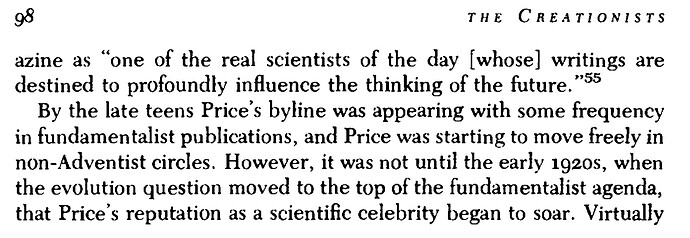Then you aren’t a Pauline Christian. What problem? I have complete faith in evolution as the only possible explanation for the diversity of life on Earth and all other infinite worlds from eternity. I don’t recall Jesus preaching electromagnetism.
Ellen White also had visions about the harmful effects of “self-abuse” (if you know what I mean). She wrote,
"The state of our world **was presented before me** , and my attention was especially called to the youth of our time. **Everywhere I looked, I saw** imbecility, dwarfed forms, crippled limbs, misshapen heads, and deformity of every description. Sins and crimes, and the violation of nature's laws, **were shown me** as the causes of this accumulation of human woe and suffering. **I saw** such degradation and vile practices..."
She wrote about this “vice” in her first book, “An Appeal to Mothers”
And more power to 'em. But there’s two sides to that coin. The other side is that “the people here” are trying to show that you don’t have to abandon Christianity to be a scientist. (Hint, hint.) Let him who has ears, hear.
I don’t. Why don’tcha 'splain it to me.
I see ya got yer special anti-SDA house slippers on again. It may come as a surprise to you, but–like some Episcopalians–SDAs don’t believe in hell,
Okay, now you’ve “stumped” me. So let’s take a little trip down memory lane together and see if refreshing your memory will help you “un-stump” me.
- A. I wrote:
- B. You responded with:
- C. And I replied:
- D. To which you responded with:
- As much as I appreciate the quotes that you offer which direct my attention to what Price wrote or said, I’m still left wondering–as much as I wondered when I first asked–which words, in the generous quotes you provided, you think offered or gave a negative or disparaging description of Ellen G. White, saying that the ravings of a madwoman deemed a prophetess of the Seventh Day Adventist Church" were his “inspiration”.
- Wanna try again?
Price was a Seventh Day Adventist. Obviously, he believed EG White’s prophecies. He also saw the material in White’s book “Patriarchs and Prophets” as something he could use to argue against the scientific consensus, which he did.
Do you disagree with any of this? If so, why?
You’re testin’ me, fella. Do you have some good reason for expecting me to be a knowledgeable expert in creationism history and you get to slide by painting broad-stroke charactures of Ellen G. White, George McCready Price, et al? You may think you’re a great dance partner, but I don’t: you keep stepping on my toes and all you seem to want to do is play the “Reality Check” game.
- Reality Check #1: Price was an SDA according a good number of folks, including Price himself and … Ronald Numbers, too.
- Reality Check #2: Price believed E.G. White’s prophecies. In confirmation, I submit Ronald Number’s quotation of words from Price’s own lips, to wit:
- Pause and read the last sentence of what I just showed you, again. Price said: “due to our faith in the simple Bible narrative, (supplemented by the writings of Mrs. E.G. White”.) IMO, there’s a bit of a parallel between Price’s view of White’s writings and the Qur’an. Both Price and Muslims have believed their prophet’s writings are divine gifts.
- Reality Check #3. Price saw material in White’s book “Patriarchs and Prophets” …
He did indeed. As reported in James L. Hayward’s biography of George McCready Price found in the Encyclopedia of Seventh-day Adventists, which you yourself shared wiyh me Price, George McCready (1870–1963):
- James L. Hayward, Ph.D. (Washington State University), is a professor emeritus of biology at Andrews University where he taught for 30 years. He is widely published in literature dealing with ornithology, behavioral ecology, and paleontology, and has contributed numerous articles to Adventist publications. His book, The Creation-Evolution Controversy: An Annotated Bibliography (Scarecrow Press, 1998), won a Choice award from the American Library Association. He also edited Creation Reconsidered (Association of Adventist Forums, 2000).
- Reality Check #4. Price “saw the material in White’s book “Patriarchs and Prophets” as something he could use to argue against the scientific consensus, which he did.” Really? what material. I have a rudimentary understanding. Do you have a clue? You should; you’re the one who saw fit to share a link in this thread to: Wise, K.P. 2018. Contributions to creationism by George McCready Price. In Proceedings of the Eighth International Conference on Creationism, ed. J.H. Whitmore, pp. 683–694. Pittsburgh, Pennsylvania: Creation Science Fellowship.
-
- Price’s Theology
A. The Nature of Revelation
Price (1916, p. 81) believes the Bible is a source of absolute truth, designed to provide information from God that humans could not discover on their own (Price 1916, p. 211; Price 1934, pp. 152-153). Because of this, Price (1916, p. 13) believes that the Bible is authoritative over the conclusions of science. Viewing Scripture through his appreciation of logic, Price believes Scripture is an example of divine inductive logic. Price (1916, pp. 29-35) believes God, in Scripture, lays out history and facts, and from those demonstrable truths argues with syllogistic certainty to absolute truth. As a consequence, Price sees the Bible—and Christianity—founded on the historicity of Genesis. This explains why Price devoted his life to demonstrating the historicity of the early chapters of Genesis.
- Price’s Theology
- Price (1911, pp. 170-171) believes God will reveal a scientific (deductive) case for scriptural truths which is built on the demonstrable facts of the book of nature—a case that will leave
people in the end times ‘without excuse’. That Price believed he was called to present this case explains Price’s enthusiasm and productivity on the matter of creation and the Flood. - LOST CREDIT
According to Morris himself (1993, pp. 168-169), the geology of the early manuscripts of The Genesis Flood was “…essentially merely a survey of George McCready Price’s arguments”. But, since “…Price himself had failed to make much of an impact with these same arguments…” (Morris 1993, p. 169), Morris “… suggested that a new approach was needed…”—an approach that resulted in Whitcomb and Morris (1961).
-
(To be continued)
(Continued from last post, which ended with a cursory selection of comments from his 2018 paper, “Contributions to creationism by George McCready Price”. The cursory selection continues here.)
- ECHOES OF PRICE IN MODERN CREATIONISM
Given how important the geology of Whitcomb and Morris (1961) was to young-age creationism to follow—and creationism of today—George McCready Price’s contributions are almost certainly important to modern creationism. - B. Biblical Interpretation
Several points of Price’s biblical interpretation are probably a direct consequence of teachings more or less unique to Seventh-Day Adventism. These same beliefs in modern Seventh-Day Adventists would more properly be echoes—along with Price’s beliefs—of SDA teaching than echoes of Price’s beliefs. However, other SDA teachings are almost certainly foundational to young-age creationism as a whole as it developed through the twentieth century. The prominent role of a literal interpretation of the Sabbath in SDA teaching played a powerful role in arguing for a 144-hour-long period of creation, a perfect initial creation, distinct processes of creation and sustenance, and in arguing against the day-age theory. Biblical arguments for young-age creation are strongest from an SDA perspective, and there is little doubt that young-age creationism as a whole owes its existence (or at least popularity) to this SDA perspective in general, and perhaps to Price’s elaboration of it in particular. - A majority of Price’s argumentation is a critique of the geological column.
- CONCLUSION
For the first couple decades of the twentieth century, George McCready Price was the most well-known young-age creationist in the world. - Price was also a prodigious writer over more than half of a century—even in Christian circles outside of Seventh-Day Adventism. If, in the general population, interest in young-age creationism increased in the first half of the twentieth century—and the number of people publishing on the subject indicates it did—George McCready Price played a pivotal role for that ebb of interest.
- At the same time, Price’s publications, teaching, and (short-lived) deluge society incubated the next generation of creationists. For example, although Henry Morris is frequently pointed to as the father of modern creationism, a young Henry Morris had a ‘life-changing experience’ reading Price’s Illogical Geology. Morris also read most of Price’s books, and became a member of Price’s society. Furthermore, a comparison (above) of Morris’s main geology chapter in The Genesis Flood with Price’s works leaves no doubt that Price’s work formed the major backbone of the geological argument of the Genesis Flood. It would seem unavoidable that Morris’s influence on later creationists would result in modern creationism being substantially impacted by the works of George McCready Price. Many of the ‘echoes’ of Price’s work in modern creationism mentioned above are probably rooted in the claims of George McCready Price.
- By one hundred years ago, Price had laid out most of the major elements of modern creationism. … Part of the tragedy in all this is that most modern creationists know nothing about the importance of George McCready Price in their present discussions. Ultimately, this seems to go back to a decision of Whitcomb and Morris not to cite Price’s intellectual
contributions to their work. It may even be true that Whitcomb and Morris’ example was followed by other creationists as if it were proper procedure in creationist studies. For whatever reason, not citing the intellectual contributions of other creationists— i.e. effectively the sin of stealing intellectual property—has become something of the norm in creationism. One of the consequences of this is that the intellectual history of modern creationism is spotty at best, and unknown in most instances. - From here we need to determine where George McCready Price got his ideas. In some cases, Price identifies the sources of his ideas—scientists like William Dawson, popular writers like Henry Howard, and Seventh Day Adventist writers like Ellen G. White. In other cases Price does not identify his sources and determining his sources will be more difficult. But from research of this sort we can determine what ideas are actually the product of George McCready Price himself, and thus what was his true intellectual contribution. While, however, we are identifying the true intellectual contribution of Price, we need to be determining what influence Price had on others. How many of what this article identifies as ‘echoes’ of Price actually did come through the work of Price? How much of Price’s work—both that portion borrowed from others and that portion birthed in Price’s mind—was passed on to others? Who passed it on, and what was their contribution? How much of what we believe or debate about today is based on Price? How much of what we believe today is no longer justified, but believed only because it was passed on? How much of the discussion has been lost along the way that might actually be valuable to us in our discussion today? These are a few of the many things we could come to understand as we reconstruct the intellectual history of our discipline.
(To be continued)
It was in the quote I gave you.
One of White’s arguments against evolution and geology is that there wasn’t the invariable order of fossils that geologists claimed there was. Price picked up on that argument and used it in his own arguments. I am wiling to bet there are more examples if you think it is worth digging through.
If I correctly understand where Terry is going in his argument that isn’t enough. You would have to show that an idea originated with White and therefore Price had to have picked it up from her. Hard to do when White took ideas from a variety of sources without attribution (kinder version of plagiarize). Given White added details to the story of the global flood that were given in a vision I don’t know why that wouldn’t be enough.
@Terry_Sampson is free to cite those other sources.
Citing sources has been sort of a personal passion of mine for many years, even if I don’t do it 100% of the time. It’s one of the reasons I admire Ronald Number’s stuff so much. The pleasure I get from it, unfortunately, is diminished by those who are confused by details and don’t want to take the time to enjoy them. Two of my all-time favorite quotes are John Muir’s “When we try to pick out anything by itself, we find it hitched to everything else in the universe.” and T.S. Eliot’s “We shall not cease from exploration, and the end of all our exploring will be to arrive where we started and know the place for the first time.”
This thread’s OP does a really shoddy job of citing sources. The Youtube linked by it doesn’t do much better.
Someday, I hope someone gets around to citing the source for the Biologos joke about “the origins of YEC-ism”, i.e. who’s the first person around here who told it?
Found this from 2015
I read several sources that seemed to have solid references, and they seemed to agree with one another. Kurt Wise has written on the matter as well, and he is a died in the wool YEC so bias shouldn’t be a problem. When there are several well researched sources saying the same thing I think it is worth tentatively accepting what they say. Of course, following up is always a good idea.
I also found it interesting that George McCready Price was part of the leadership within the larger Christian fundamentalist movement.
Having quoted Kurt liberally above, I respect his even-handed and informative style and his readiness and ability to cite sources, although I was a little confused by his comment that, “If, in the general population, interest in young-age creationism increased in the first half of the twentieth century—and the number of people publishing on the subject indicates it did—George McCready Price played a pivotal role for that ebb of interest.” I suspect that he meant: Price played a pivotal role for that rise in interest.
I’m inclined to agree, … and I ain’t "askeered.
And I found it more interesting that the SDA Encyclopedia entry for G.M. Price gives a slightly different view of the “Reception of Price’s Views” than R. Numbers gives. According to Numbers,
I see a guy barely eking a living and scarcely noticed" by non-SDA because there more important matters to attend to and "“also because of what evangelical Christians regarded as Price’s cultish Adventist theology.” Gee, how surprising that being SDA wasn’t getting him any traction among the non-SDA. Guess Mrs. E.G. White’s visions or prophetess status wasn’t convincing to outsiders, eh?
Price’s creation and flood geology didn’t become heavily publicized until his publisher, Fleming H. Revell, brother-in-law of the deceased charismatic “father of modern mass revivalism” Dwight :L. Moody, persuaded the most famous and popular Southern Baptist evangelist in America, William Bell Riley–no friend of Adventism, who invented the “fundamentalist” label–to invite Price to a gathering of fundamentalist “big names” in Colorado Springs where Price met Charles G. Trumbull, Kenswick Movement fan, publisher of the widely known The Sunday School Times, and disciple of C.I. Scofield of “Scofield Bible” fame. Hard for me to see that E.G. White’s “vision” was more important in Price’s career than Riley and Trumbull’s influence, but if someone else wants to ignore the latter and elevate the influence of the former, go for it.
" Not only that but it is interesting to note that evolutionists were not getting what they wanted regarding age of the earth for quite a while"
Also, Darwin’s guesses on age were wild overestimates, compared to modern dates.
Actually, convection in the mantle would lower Kelvin’s ages, if we ignore radiometric decay. Convection allows the heat to escape faster than conduction alone.
“Maybe, just maybe, Young Earth Creationism is actually the way everyone in the church including the apostles have seen Genesis 1 for thousands of years”
What is meant by young-earth creationism? The modern version of young-earth creationism is rooted in the demand that Genesis 1 be interpreted as a scientific account of a creation event only a few thousand years ago in the span of one week, and that Noah’s flood was global and produced much of the geologic column. As such, it is a modernistic approach, seeing science as the top authority. Historically, people who thought that the age of the earth was only a few thousand years were much more open to the possibility of symbolic and other meanings in Genesis 1. Imposing a modern concern for old versus young creation conceals a more fundamental difference between eternal versus finite age. Many religious and philosophical positions, including much classic Greek thought, Hinduism, and Enlightenment deism favored eternal; the Bible and modern science both support a finite age for the earth and our universe. Old-earth geology grew out of the historical focus of workers such as Ussher, whose date is inappropriately invoked by modern young-earthers. As a result, the evidence for increasing the estimated age of the earth was not seen as a theological problem by the vast majority in the late 1700’s through the mid-1900’s. True, evolution and an old earth have often been invoked as excuses to disbelieve the Bible, but rather than uncritically accepting those claims and attacking the science, we should look carefully and see whether the claimed links between evolution or an old earth and doubt are valid.
“Perhaps she really was a prophet of God and He inspired her to write these things in direct response to the apostacy of evolution? Could that in fact be true? Can evolutionists prove its not true? I mean that is really the question here is it not?”
It is highly implausible, as the arguments made against evolution are not good. Evolution is not an apostasy; it is a model of the process for creating new kinds of organisms. Claiming that a scientific model removes God from the picture is not biblical; the Bible affirms that God is at work in natural-law processes. Young-earth creationism and ID antievolution often makes supporting their scientific claims to be the test of faith, rather than any evidence of faith in Christ. [E.g., Jonathan Wells claiming that it is OK for him to claim to be a Christian while holding that Rev. Moon is the Messiah because he says that Christianity is about antievolutionism, not about Christ.] As a result, it is such young-earth or antievolutionary claims that are apostate and heretical.
From the article I linked above.
Convection inside the earth increases the efficiency of heat loss. On the one hand, that would keep the outside from cooling as quickly, because it would be getting more heat. But on the other, it would mean that the earth’s interior would cool much faster.
The article that you linked makes the case that the slower cooling of the outside is the main error in Kelvin’s calculation.
The main error was Kelvin’s assumption that the earth is rigid. Which is interesting given geologists had suspected the mantle was fluid.





